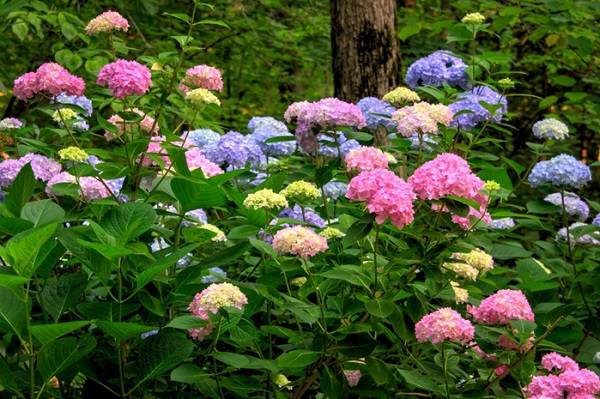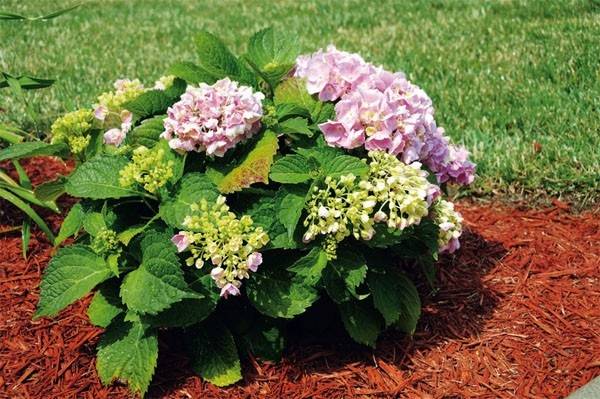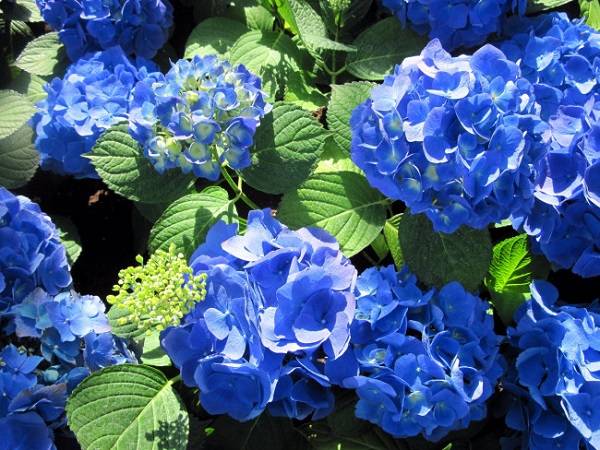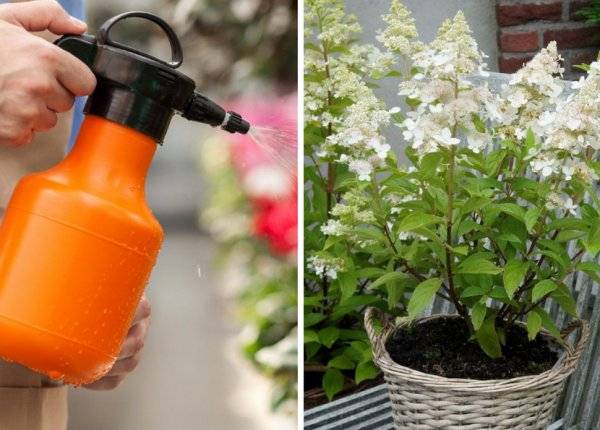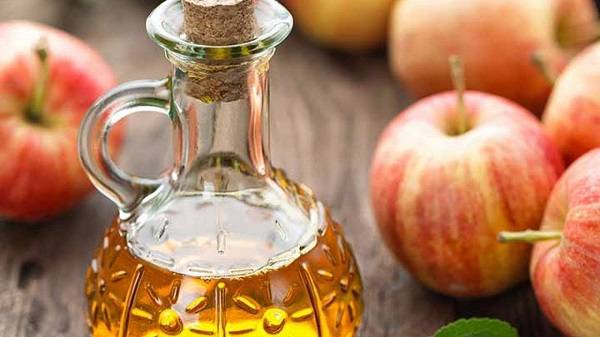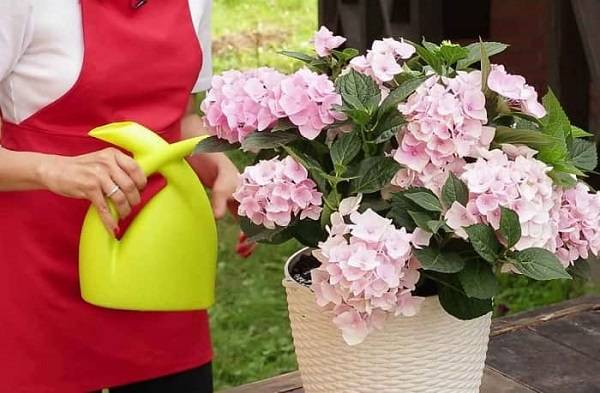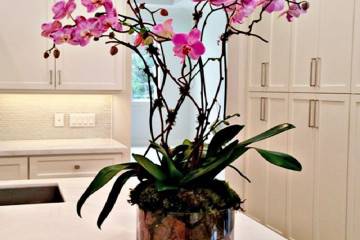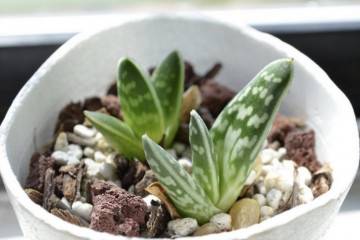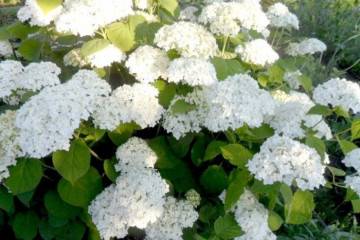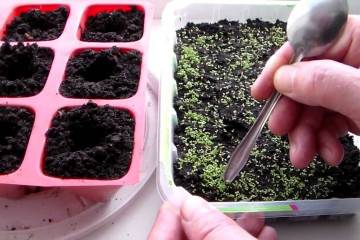How to water a garden hydrangea correctly
Content:
The homeland of the beautiful hydrangea is the territory of China and Japan. In most cases, it is a treelike shrub with huge paniculate inflorescences. The diameter of one flower is about 30 cm. Lianas and trees are less common. Differs in long flowering from spring to autumn. The color of the flowers is predominantly white. You can artificially dye it in blue, pink and purple.
How to know if a hydrangea needs watering
The plant is very fond of water, so frequent and systematic watering is required. At least 2 times every 7 days. The signs of a lack of moisture can be yellowing of the leaves, their drying out, and the absence of flowering.
It is worthwhile to draw up a schedule for how to water the hydrangea. However, this does not mean that it is necessary to water only in strict accordance with it. In frequency, you need to be guided by the weather. For example, with frequent and heavy rainfall, it is reduced to once a week. When the rains do not stop, a canopy is installed over the bushes (for garden varieties).
Water requirements
Soft water is suitable for watering. It can be boiled or just well-kept. The best option is melt water at room temperature or collected after rain. Sometimes acidifying watering is carried out, with the addition of lemon juice or other acidifying substances.
Frequency and rules for watering garden hydrangea
Garden varieties require more water due to their size and different growing conditions. Age has no role in watering. In any case, the soil must be sufficiently moist. Below is how to properly water a garden hydrangea.
The general rate for watering hydrangeas growing in the garden is up to 5 liters, 2 times in 7 days per shrub. It is necessary that the soil is properly saturated with moisture. The basic rule of watering is gradual. You do not need to immediately pour all 5 liters onto the bush. This is done gradually.
In open ground conditions, mulching is recommended. As a material, peat chips, needles, sawdust are perfect. Mulch retains moisture well and helps to reduce the frequency of watering.
After landing or transplant
Planting and transplanting is always stressful for any plant. Watering a hydrangea transplanted in spring can only be done after 2-3 days. This delayed watering will protect the plant's root system from hypothermia. What is the difference between a spring hydrangea transplant and an autumn one? Practically nothing, but there are still several differences: the shoots of the bush are not cut off, except for dry branches and peduncles. Water the shrub immediately after transplanting. The transplanted bush is not fertilized so as not to provoke the growth of shoots.
Hydrangea: care during flowering
During this period, watering is used with the addition of dressings. After the plant fades and goes into a dormant stage, watering must be reduced.
What can be added to water for watering hydrangeas
For feeding, as well as obtaining the desired color of flowers, various useful substances are added to the water.
To change the color
Hydrangea is a chameleon plant that can change the color of its petals. The reason lies in the presence of complex chemical reactions inside the plant. The vegetable juice contains a pigment called delphinidone 3-monoglycoside. When this substance interacts with aluminum, the corolla turns blue.
To change the color to purple or pink, it is necessary to increase the acidity of the soil to 5.5 so that the aluminum is not absorbed. The content of this element in the soil affects the final color of flowers. With a small amount of it, the corollas become pale blue.
The presence of other trace elements also affects the color. For example, to obtain a blue color, phosphorus supplements are reduced. Potassium also helps to achieve blues and blues. To change the color of the buds, you can use simple tools that every housewife always has at hand.
Lemon acid
It is used to maintain the acidity of the soil. To prepare a coloring solution, take 2 tbsp. l. acid (in powder form) per 10 liters of water. Stir well and water. 5 liters of solution is enough for 1 sq. meter. The break between watering is from 10 to 15 days.
Potassium permanganate
A weak solution of potassium permanganate will only benefit the exotic beauty. Gives the pink color that is most in demand among florists. In addition, such watering will be an excellent prevention against fungus, maintain the level of hydrogen, strengthen the trunk and wood. After such a procedure, luxurious flowering is guaranteed. The solution should be weak and light pink in color.
A weak solution of potassium permanganate is used for both irrigation and spraying. The frequency of application is 3 times per spring with a break of 14-12 days.
Vinegar
Malic acid should be at a concentration not higher than 9%. For 5 liters, 0.1 liters of the product is required. Irrigation is carried out immediately after the plant leaves the dormant period. Irrigate once every 14 days until the season ends. For 1 sq. m, 2 buckets of water are enough.
Alum
Watering hydrangeas with aluminum alum is a great way to get a blue-blue color and maintain acidity at the right level. You can buy alum at the pharmacy. For 1 liter of water, only 5 g of the substance is required. One shrub takes up to 2 liters of solution. Watering frequency 2 times every 30 days.
Copper sulfate
The substance is represented by blue salt crystals. Most often it is used as an antibacterial agent to protect soil microflora. For fertilization, take a 1% solution. For 10 liters of water, 5 grams of vitriol is enough. Spring watering is preferable, at intervals of 2-3 weeks.
For feeding
Now there are many options for different dressings, both chemical and organic. Simple folk remedies are still popular:
- Organic. All organic fertilizers are safe for plants when dosed correctly.
- Kefir, milk (sour), milk whey. Any product from the fermented milk series will do. The simplest recipe: diluting kefir with water in a ratio of 1: 4.
- Manure, droppings. Chicken droppings or manure (well rotted) are suitable as fertilizers. The ratio with water is 1:10. Alternate with chemical dressings.
- Bread or yeast feeding. Only rye bread or dry yeast prepared in advance according to the instructions will do. The bread is soaked in warm water in a volume of 10 liters for 2-3 days. It is important to prepare the solution warm for fermentation to begin. Filter the solution before adding.
- Urea. For 5 liters of water, take urea in the amount of 25-30 grams. For 1 sq. m. make 1 bucket.
- Vinegar and other acidifying agents. It is used to increase the acidity of the earth. For 5 liters of water, 40 g of citric acid is enough.
Many plants love wood ash. It alkalizes the soil, so when asked whether hydrangea loves ash, the answer is obvious - no.
Chemical fertilizers
Mineral fertilizers are single-component and prefabricated. Some of the simplest and most effective means of "Agrocol" and "Nitrofoska".
Agricola is a specialized product made for hydrangeas. It contains all the important micronutrients. Presented in liquid form with humate content. "Nitrofoska" is a complex fertilizer. Effective in summer. Suitable for plants in the open field in the garden and indoor. Perfectly protects against insects and prevents early leaf fall.
What is the difference between watering garden and room hydrangeas
Any hydrangea does not tolerate heat - both indoor and garden. And they love watering and spraying alike. Only in the case of a garden room do they take large volumes of liquid. Those plants that are at home can be watered through the bottom by placing the pot more than half in the water for 30 minutes. Houseplants are more capricious. In warm weather, they can be taken out into the open space (if possible).
Frequent mistakes when watering hydrangeas and their consequences
It is important to always remember about acidification, as it helps the plant to absorb iron - an important trace element. Its deficiency leads to chlorosis of the foliage, when the plate begins to turn yellow in the center, and remains green around. Therefore, watering only with water is not correct. Lack of iron can ultimately lead to death.
Excessive watering in cold weather is contraindicated. This will lead to stagnation of moisture and decay. Fungus infection is also possible. With frequent use of chemicals for irrigation (when planting hydrangeas in the open field), the site will not be suitable for other plants.
Hydrangea is a beautiful flower that can easily decorate a garden, an apartment or a house. Interesting in that it can change the color of flowers. Good growth and flowering requires careful watering and acidification, as well as timely feeding.
